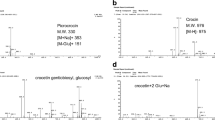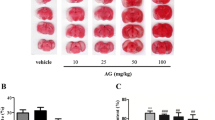Abstract
Objective
To study the effects of the Weinaokang (维脑康, WNK), the active compounds extracted from Ginkgo, Ginseng, and saffron, on ischemia/reperfusion (I/R)-induced vascular injury to cerebral microvessels after global cerebral ischemia.
Methods
Male C57BL/6J mice were randomly divided into 5 groups (10 animals/group): the sham group (0.5% CMC-Na, 20 mL/kg), the I/R model group (0.5% CMCNa, 20 mL/kg), the I/R+Crocin control group (20 mg/kg), the I/R+high dose WNK group (20 mg/kg), and the I/R+low dose WNK group (10 mg/kg). Bilateral common carotid artery occlusion (BCCAO, 20 min) in mice, followed by 24 h reperfusion, was built. The generation of nitric oxide (NO), the activity of nitric oxide synthase (NOS), the phosphorylation of extracellular signal-regulated kinase1/2 (ERK1/2), and the expression of matrix metalloproteinases-9 (MMP-9) and G protein-coupled receptor kinase 2 (GRK2) in cortical microvascular homogenates were evaluated. The ultrastructural morphology of cortical microvascular endothelial cells (CMEC) was observed.
Results
The transient global cerebral ischemia (20 min), followed by 24 h of reperfusion, significantly promoted the generation of NO and the activity of NOS. The reperfusion led to serious edema with mitochondrial injuries in the cortical CMEC, as well as enhanced membrane GRK2 expression and reduced cytosol GRK2 expression. Furthermore, enhanced phosphorylation of ERK1/2 and decreased expression of MMP-9 were detected in cortical micovessels after I/R (20 min/24 h). As well as the positive control Crocin (20 mg/kg, 21days), pre-treatment with WNK (20, 10 mg/kg, 21 days) markedly inhibited nitrative injury and modulated the ultrastructure of CMEC. Furthermore, WNK inhibited GRK2 translocation from cytosol to the membrane (at 20 mg/kg) and reduced ERK1/2 phosphorylation and MMP-9 expression in cortical microvessels.
Conclusion
WNK and its active compounds (Crocin) are effective to suppress I/R-induced vascular injury to cerebral microvessels after global cerebral ischemia with the target on GRK2 pathways.
Similar content being viewed by others
References
Fagan SC, Hess DC, Hohnadel EJ, Pollock DM, Ergul A. Targets for vascular protection after acute ischemic stroke. Stroke 2004; 35: 2220–2225.
Gursoy-Ozdemir Y, Can A, Dalkara T. Reperfusion-induced oxidative/nitrative injury to neurovascular unit after focal cerebral ischemia. Stroke 2004; 35: 1449–1453.
Maier CM, Hsieh L, Crandall T, Narasimhan P, Chan PH. Evaluating therapeutic targets for reperfusion-related brain hemorrhage. Ann Neurol 2006; 59: 929–938.
He SY, Qian ZY, Tang FT, Wen N, Xu GL, Sheng L. Effect of Crocin on experimental atherosclerosis in quails and its mechanisms. Life Sci 2005; 77: 907–921.
Sugiura M, Shoyama Y, Saito H, Abe K. Crocin (crocetin digentiobiose ester) prevents the inhibitory effect of ethanol on long-term potentiation in the dentate gyrus in vivo. J Pharmacol Exp Ther 1994; 271: 703–707.
Zhang Y, Shoyama Y, Sugiura M, Saito H. Effects of Crocus sativus L. on the ethanol-induced impairment of passive avoidance performances in mice. Biol Pharm Bull 1994;17: 217–221.
Mdzinarishvili A, Kiewert C, Kumar V, Hillert M, Klein J. Bilobalide prevents ischemia-induced edema formation in vitro and in vivo. Neuroscience 2007; 144: 217–222.
Zhang G, Liu A, Zhou Y, San X, Jin T, Jin Y. Panax ginseng ginsenoside-Rg2 protects memory impairment via anti-apoptosis in a rat model with vascular dementia. J Ethnopharmacol 2008; 115: 441–448.
Huang Y, McNamara JO. Ischemic stroke: “acidotoxicity” is a perpetrator. Cell 2004; 118: 665–666.
Shah ZA, Gilani RA, Sharma P, Vohora SB. Cerebroprotective effect of Korean ginseng tea against global and focal models of ischemia in rats. J Ethnopharmacol 2005;101: 299–307.
Zheng YQ, Liu JX, Wang JN, Xu L. Effects of Crocin on reperfusion-induced oxidative/nitrative injury to cerebral microvessels after global cerebral ischemia. Brain Res 2007;1138: 86–94.
Preston E, Webster J. Differential passage of [14C]sucrose and [3H]inulin across rat blood-brain barrier after cerebral ischemia. Acta Neuropathol (Berl) 2002;103: 237–242.
Gursoy-Ozdemir Y, Bolay H, Saribas O, Dalkara T. Role of endothelial nitric oxide generation and peroxynitrite formation in reperfusion injury after focal cerebral ischemia. Stroke 2000; 31: 1974–1980.
Mark KS, Burroughs AR, Brown RC, Huber JD, Davis TP. Nitric oxide mediates hypoxia-induced changes in paracellular permeability of cerebral microvasculature. Am J Physiol Heart Circ Physiol 2004; 286: H174–180.
Harris CA, Chuang TT, Scorer CA. Expression of GRK2 is increased in the left ventricles of cardiomyopathic hamsters. Basic Res Cardiol 2001; 96: 364–368.
Hata JA, Williams ML, Schroder JN, Lima B, Keys JR, Blaxall BC, et al. Lymphocyte levels of GRK2 (betaARK1) mirror changes in the LVAD-supported failing human heart: lower GRK2 associated with improved beta-adrenergic signaling after mechanical unloading. J Card Fail 2006;12:360–368.
Liu S, Premont RT, Kontos CD, Zhu S, Rockey DC. A crucial role for GRK2 in regulation of endothelial cell nitric oxide synthase function in portal hypertension. Nat Med 2005;11: 952–958.
Imura T, Shimohama S, Sato M, Nishikawa H, Madono K, Akaike A, et al. Differential expression of small heat shock proteins in reactive astrocytes after focal ischemia: possible role of beta-adrenergic receptor. J Neurosci 1999;19:9768–9779.
Fardoun RZ, Asghar M, Lokhandwala M. Role of oxidative stress in defective renal dopamine D1 receptor-G protein coupling and function in old Fischer 344 rats. Am J Physiol Renal Physiol 2006;291: F945–951.
Mak JC, Hisada T, Salmon M, Barnes PJ, Chung KF. Glucocorticoids reverse IL-1beta-induced impairment of beta-adrenoceptor-mediated relaxation and up-regulation of G-protein-coupled receptor kinases. Br J Pharmacol 2002;135: 987–996.
Cobelens PM, Kavelaars A, Heijnen CJ, Ribas C, Mayor F, Penela P. Hydrogen peroxide impairs GRK2 translation via a calpain-dependent and cdk1-mediated pathway. Cell Signal 2007;19:269–277
Hagen SA, Kondyra AL, Grocott HP, El-Moalem H, Bainbridge D, Mathew JP, et al. Cardiopulmonary bypass decreases G protein-coupled receptor kinase activity and expression in human peripheral blood mononuclear cells. Anesthesiology 2003;98: 343–348.
Author information
Authors and Affiliations
Corresponding author
Additional information
Supported by the Project of National Natural Science Foundation of China (No. 30830118), the National Key New Drug Project (No. 2009ZX09102-137, 2009ZX09502-014)
Rights and permissions
About this article
Cite this article
Zheng, Yq., Liu, Jx., Li, Xz. et al. Effects and mechanism of Weinaokang (维脑康) on reperfusioninduced vascular injury to cerebral microvessels after global cerebral ischemia. Chin. J. Integr. Med. 16, 145–150 (2010). https://doi.org/10.1007/s11655-010-0145-5
Received:
Published:
Issue Date:
DOI: https://doi.org/10.1007/s11655-010-0145-5




